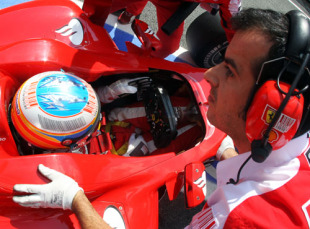- Technical news
FOTA agrees to ban F-ducts from 2011

- Drivers:
- Fernando Alonso
- |
- Christian Horner
- Teams:
- Alfa Romeo
- |
- Ferrari
- |
- McLaren
- |
- Mercedes
- |
- Williams
Formula One teams have agreed to ban the use of F-ducts from the start of the 2011 season.
The novel aerodynamic device pioneered by McLaren manipulates airflow to the rear wing to stall it and increase top speed on the straights. The driver can switch between a stalled and fully-working rear wing in order to have the best straight-line speed and maximum grip in the corners.
The legality of F-ducts was questioned at the start of the season but the FIA declared the McLaren system legal. As a result Ferrari, Mercedes, Williams and Sauber have attempted to copy the idea, but with varying degrees of success.
The Ferrari solution requires the driver to take his hand off the steering wheel, and concerns over safety and escalating cost were the primary reasons why the majority of teams voted to ban F-ducts, despite McLaren's best attempts to convince them otherwise.
Red Bull's Christian Horner said: "It is a clever piece of engineering and hats off to the guys who invented it, but some of the solutions this weekend look a bit marginal when you see drivers driving with finger tips and no hands," he explained. "So I think there is a safety issue and a cost issue to take into account."
Mercedes Nick Fry added that a continued spend on the technology would not be useful for F1 or road cars, and could take technological developments in the sport down the wrong route.
"The trouble with these devices is that most of the top teams, if not all the teams, will have an F-duct-type device before the end of the year," Fry told the BBC. "We'll all have got it so we'll have neutralised the advantage McLaren have currently got and therefore we're just spending money on it.
"Formula One should encourage the things that are going to be used on road cars and I think this is why some of us [in the Formula One Team's Association] and the FIA feel passionate about things like KERS - because it's the type of thing that is going to be on a road car and save energy. I'm not sure an F-duct, where a driver has to put his arm against an orifice to stop air going to the rear wing is particularly fruitful. The other thing that we all feel strongly about is that the F-duct interpretation opens up a whole avenue for devices to follow similar trends and we've already had discussions in our team and we've got developments going on for some very zany ideas. That is very interesting for the engineers; they love that kind of thing. But is it going in the right direction for Formula One? Is it going to be useful? I've got my doubts."

